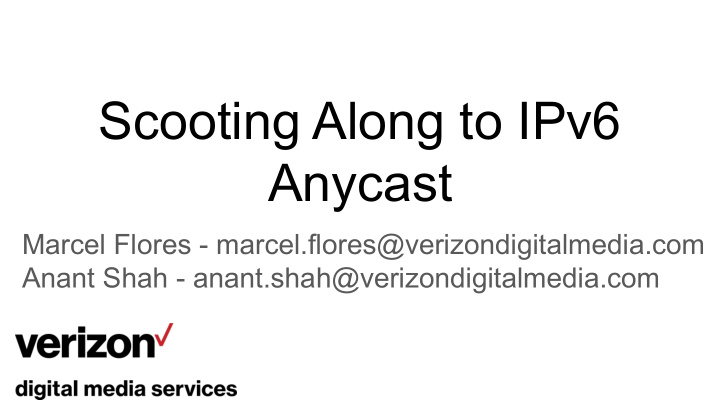



Scooting Along to IPv6 Anycast Marcel Flores - marcel.flores@verizondigitalmedia.com Anant Shah - anant.shah@verizondigitalmedia.com
Dealing With Legacy Configurations ● Some (large) legacy users have v6 explicitly disabled on the CDN ○ Rooted in concerns that IPv6 was less reliable. ● We want IPv6 on. What will happen if we turn on v6?
What do we expect? ● Differences in announcements: ○ Set of peers for v4 vs v6. ○ Provider behaviors. ● Variations in tuning: ○ Performance driven tuning applied unevenly. ● Are clients: ○ Going to use similar paths? ○ Going to connect to the same site?
External Probes DNS + NSID Probes Traceroute + Last hop Match + some BGP data
External Probes - Global Anycast ● 80% of dual stack Atlas probes map to the same anycast site. ● 70% of movers saw a decrease in performance ○ About 20% of those were significant (>20ms)
External Probes - Regional Anycast ● Here, the error is bounded approximately by continent. ● Approximately 82% map to the same location ● For the remaining 18%, about 58% of movers saw a decrease in performance
Organic Traffic ● 55% of <pop, asn> pairs perform better with v6 ● Tighter bounds overall
Organic Traffic ● Some large v4 contributors appear nearly-single stack. ● Larger v6 providers take a significant portion of the v6 share.
What about the way back? ● Probing outward (from one pop to 10k hosts in an AS) ○ The network appears different ○ Overall performance appears similar
Moving Forward ● What is going to happen if we turn v6 on? ○ Different views all look a little different? ● We have something existing to compare! ○ How do we leverage known v4 behaviors? ● How do we ensure measurements accurately reflect a future v6 user base? ○ New customers, new providers.
Recommend
More recommend